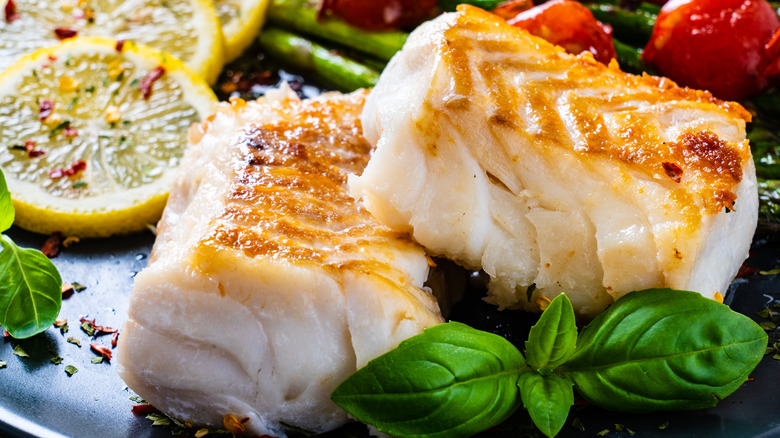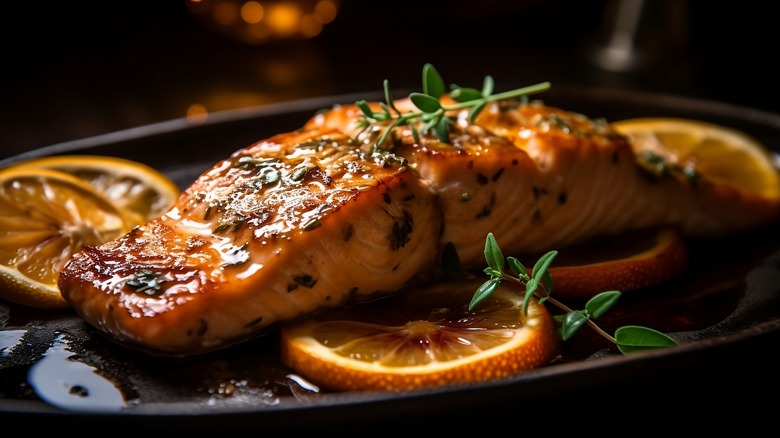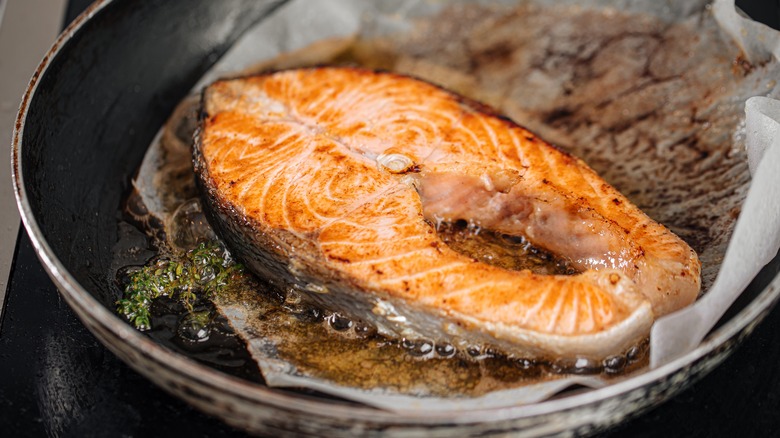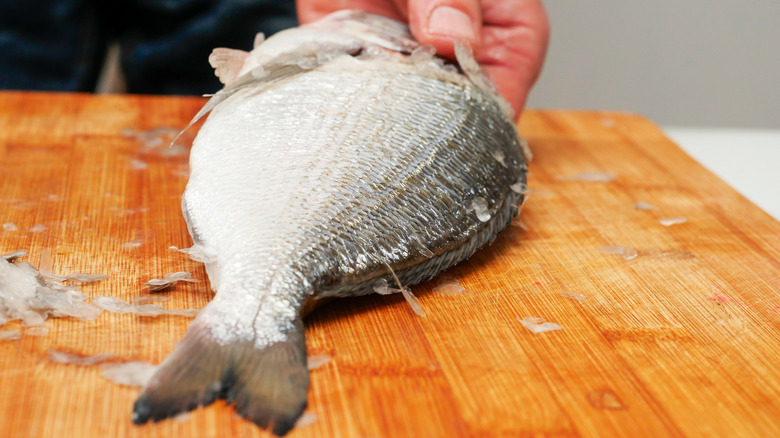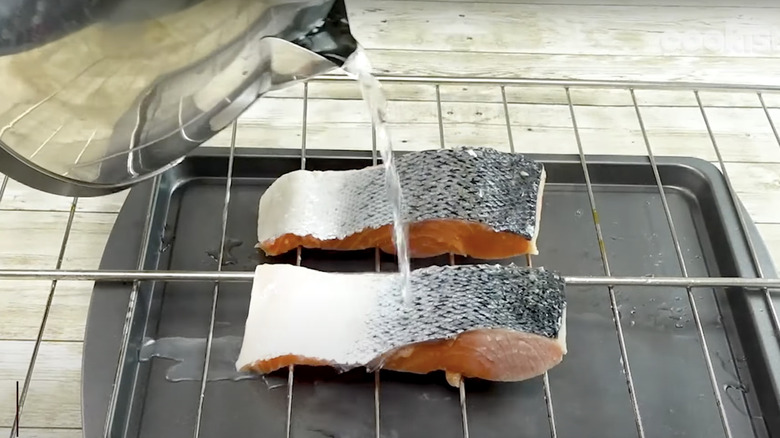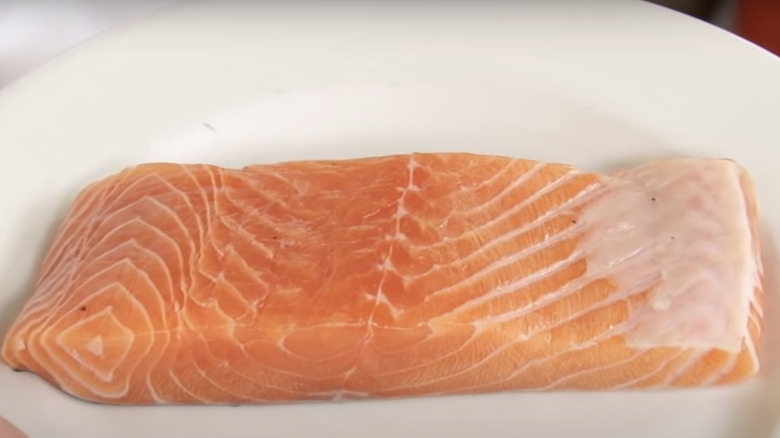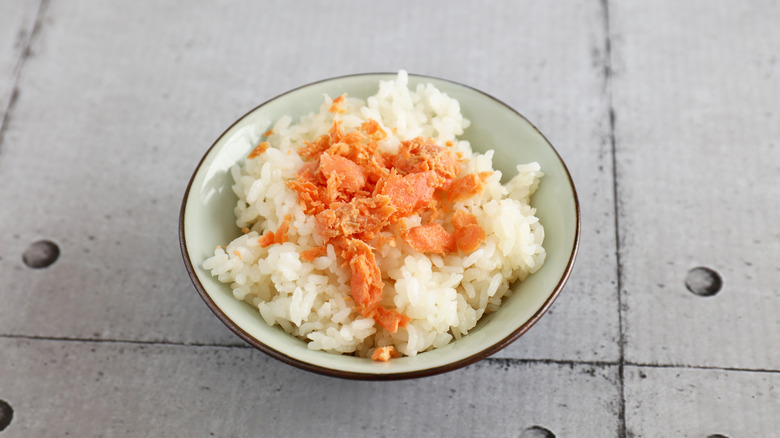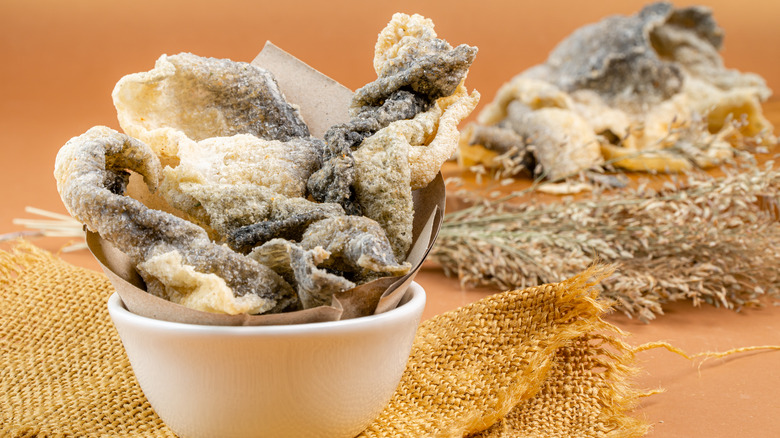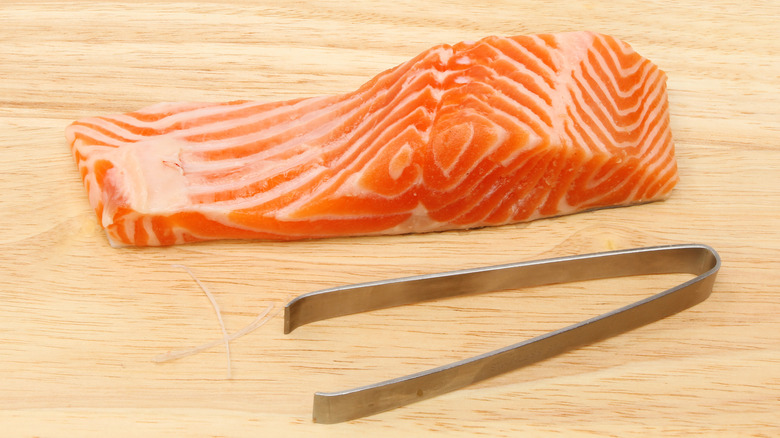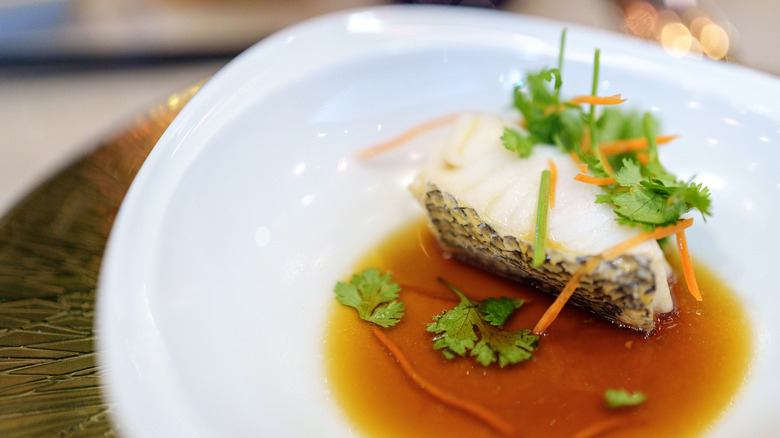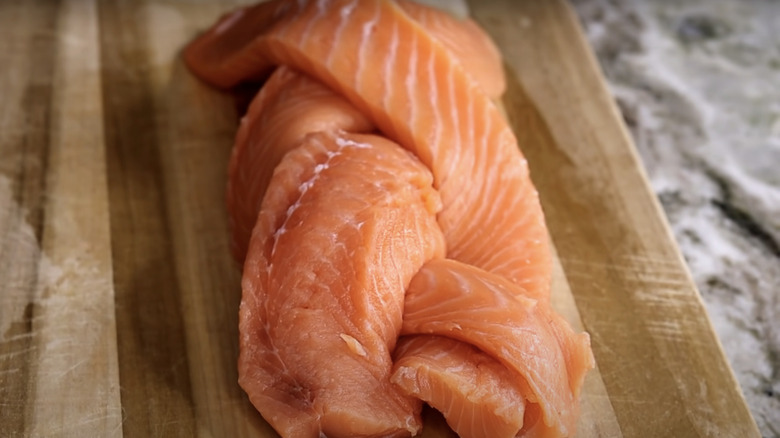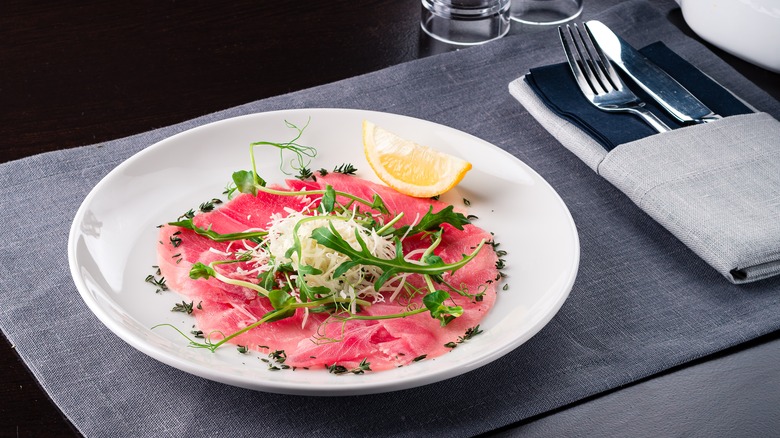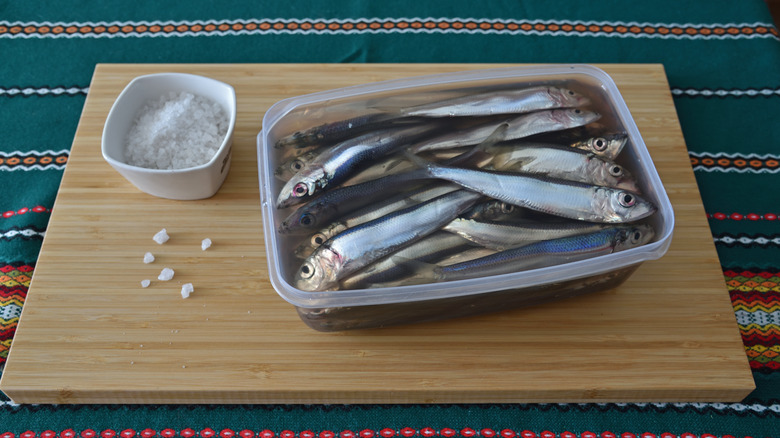12 Hacks For Cooking Fish You'll Wish You Knew Sooner
Serving fish is often a winning move. This staple protein choice is flavorful, versatile, and widely loved, and there's a fish choice out there that can suit any taste, from mild white fish like cod or haddock to bold, briny choices like mackerel or herring. However, there's no denying that it can be kinda tricky to cook. Fish differs from other proteins like chicken or beef due to its delicacy. Because fish flesh has a lower amount of connective tissue than other meats, as well as shorter muscle fibers, it can dry out and fall apart very easily. This delicacy also translates, in some instances, to a delicacy of flavor that can be lost if you get your balance of ingredients wrong, or cook it in the wrong way.
Because of this trickiness, a huge amount of care is often exercised when cooking fish, with specific attention to detail around temperature, appearance, and moisture that can feel daunting to cooks. So what if we told you that you didn't have to worry so much? It's important to be aware of the differences between cooking fish to other types of food. However, it's also important to be aware that so many of the issues around fish — it sticking to your pan, it falling apart, or it smelling too fishy — can be solved with some easy-to-execute hacks.
1. Grill your fish over lemon slices for immediate flavor
Fish can take on flavor very quickly, which is partly why they're so well-suited to marinades. Using acid in your fish marinade, however, can be a risky move. Using too much acid, or submerging it in an acidic solution for too long, can denature its proteins, which essentially causes it to cook. As such, you can quickly end up making something resembling ceviche — which may be delicious, but wasn't what you wanted for dinner.
A quick cooking hack can fix this, though, by imparting citrus flavor to your fish while it's cooking. You simply place a bed of lemon slices on your grill pan or skillet, and then place your fish fillets on top. As you do this, the lemons will heat up and start to cook, imparting delicious, charred lemon flavor directly into the porous flesh of your fish. The heat, meanwhile, will cook your fish beautifully and prevent it from drying out. As a further benefit, using lemon slices will also stop your fish from sticking to the pan, making it easy to pull off and place directly onto your plate without losing any skin or flesh.
2. Line your pan with parchment paper
Have you pan-fried fish recently? If you haven't, you may have forgotten how tricky it can be. While frying fish is, in theory, simple, unless you're using a brand-new non-stick pan or copious amounts of oil, the fish flesh can easily adhere itself to the metal. When this happens, you're left with having to prise the fillets from the pan without them ripping apart — easier said than done, due to the fish's fragile consistency.
A piece of parchment paper can solve all of these woes. All you need to do is line your pan with a round section of parchment paper and place your fish directly on top of it. The fish will heat through the parchment paper and fry just as well as it would on the surface of the metal. Using parchment paper also prevents you from having to add any oil to the pan: As the material is non-stick, your fish will be able to slide off easily, and won't get too greasy. This is a particularly good hack for fattier fish like salmon, which release their fat as they heat and keep the flesh juicy and tender. This hack is also a great move if you're baking fish: Just line your baking sheets with parchment paper, lay your fish on top, and throw them in the oven.
3. Descale fish easily using a teaspoon
Most fish bought in the supermarket is already descaled — but everyone knows that if you want the fresh stuff, you have to go to the fish market. While this can guarantee you the freshest catch of the day, though, it can also leave you with a lot more prep work than you thought. As such, if you didn't specify with the fishmonger that you needed the fish descaled, you may have a big job on your hands.
Luckily, there's an easy way to make that big job tiny, by using a tiny, easy-to-find utensil. Simply take a teaspoon, and rub it against the grain of the fish scales. This will scrape off all of the scales, without risking damaging the fish itself, as you might if you were using a knife.
Although this can take a few minutes, it's worth it. Fish scales are edible, but they're also super unpleasant to eat. These tough flakes are made from bone and collagen, and as such pose a choking risk. It's far better to get rid of them.
4. Cook skin-free salmon with boiling water
Let's face it, salmon skin isn't everyone's cup of tea. While many people love the fish's skin for its intense taste and nutritious qualities, others simply find it to be a distraction from the succulent, soft salmon flesh. Removing it , however, can be surprisingly challenging. If you've ever tried to peel off raw salmon skin, you'll know that it has a knack for bringing much of the protein with it and using a knife to remove it can see you inadvertently slicing off part of the fish flesh, or cutting your fingers.
The solution, though, is as simple as boiling a kettle. Once you've done this and the water has cooled slightly, you then pour it over the skin side of your salmon. The heat causes the skin to separate from the salmon and allows you to then peel away the skin effortlessly in one piece. It's worth pointing out that because salmon flesh is so delicate, doing this will also slightly cook the outside of the meat, so if you require your salmon to be raw for whatever reason, this may not be the hack for you. It's not a massive change, though, and the salmon fillets can still be fried or baked with little change to their cooking time.
5. Reduce fish smells by soaking it in milk
Even the most enthusiastic chefs out there can find the smell of cooking fish a little icky, especially once you've finished your meal and have to put up with the scent for hours on end. Interestingly, though, hacking your fillets by soaking them in a little milk can reduce fishy smells when cooking considerably. Fish fillets contain a compound called trimethylamine, which develops once the fish has been killed, and is responsible for causing its odor. Soaking the fish in milk for 20 minutes allows its casein to remove the trimethylamine, which is then left in the milk, and your fish will taste and smell sweet and gentle once more.
This is an especially good trick if your fish fillets are a day or two old. While freshly caught and filleted fish will have little scent, the longer fish is allowed to sit once killed, the more the trimethylamine will develop. It's useful to remember that this doesn't mean that your fish is bad, and even if you don't use this milk hack, it'll still be edible. It's way nicer to get rid of it though, right?
6. Make perfect salmon bowls with an ice cube
Salmon bowls are, in our view, the perfect dinner. However, they sometimes have a knack for being surprisingly dry and mealy. This can be especially common if you're using pre-cooked salmon or rice, as when it's allowed to sit in the fridge, it starts to lose its moisture content somewhat. Luckily, to get around this and produce moist, flavorful rice bowls, all you need is an ice cube.
Once you've placed your salmon and rice in the bowl together, you then just have to tuck an ice cube on top of the rice and cover your bowl with a piece of parchment paper. When you microwave the bowl, the ice cube will melt, and the parchment paper will trap its steam. This steam will then permeate into the rice and salmon, filling it with moisture once more and making it tender. If you don't have any ice to hand, never fear: You can also pour a little cold water into the bowl, and it will have a similar effect. Just make sure you don't add too much, as you don't want your food to become waterlogged.
7. Make chips out of your fish skin
What do you do with your leftover fish skin? Probably throw it out, right? We can understand why — it's not exactly easy to make a delicious meal out of it, and its tacky, slimy consistency isn't particularly endearing. However, you shouldn't forget that you can use it to make a surprisingly delicious snack: Fish skin chips.
You first have to boil your fish skins briefly, to make removing any fat or meat still clinging to it easier, before allowing them to dry. Then, you put your fish skins in the deep-fryer. In just a few seconds, the fish skins will turn ultra-crispy and develop a rough, bumpy texture, which provides the perfect vehicle for any seasonings you like. If you don't have a deep-fryer at home or aren't super comfortable working with hot oil, you can also use your air fryer to make crispy fish skins. After you boil and dry them, give them a quick coating with some seasoned flour, spray them with oil, and place them in the air fryer at 400 degrees Fahrenheit for 10 minutes. These crispy skins work beautifully as a snack with drinks, or as a quick bite before your appetizer to keep your guests happy.
8. Curve your fish to debone it properly
Deboning fish can be a real hassle. While many fish have pin bones, many standard fillet cuts remove them entirely, but salmon fillets can often still be riddled with them when you get them home. When the fish is laid flat, these can be nearly impossible to see, and unless you're supremely diligent, you can end up with them still in your food.
An easy hack to make this deboning process way easier is to curve your salmon fillets. Just place a small bowl upside down on your kitchen surface, and put your fillet over it. When the fish is curved, the pin bones should be more exposed and jut out of the salmon. Then, all you have to do is take your tweezers and pull them out one by one, following the grain of the flesh to ensure that you don't rip any of the fish. Make sure you do one final check once you've done this removal process so that you don't miss any bones — some of them can dig themselves in quite deep, and be easy to miss.
9. Make indulgent steamed fish with an air fryer
Cantonese-style steamed fish is a beautiful, luxurious experience. This dish is commonly associated with festivals and celebrations and is usually served whole as the showstopping centerpiece of a feast. If you're craving the flavors of steamed fish without wanting to cook the whole thing, though, it can be hellish to have to wait until the next excuse to make it.
So, harness the power of your air fryer with this easy steamed fish hack. Take a sea bass fillet, and place it on a sheet of parchment paper on top of some sliced spring onions, before topping it with julienned ginger and rice wine. You then need to make a parcel out of your parchment paper, which will trap the steam as it cooks in the air fryer. Pop the whole thing in your air fryer at 300 degrees Fahrenheit for 15 to 20 minutes.
The low temperature will help the fish to gently cook without drying out, with the aromatics slowly releasing their flavor and scent into the meat. Once the fish is done, you can then pull it out, and top it with a soy-based sauce and sliced chili, as well as your ginger and spring onions. A meal fit for a king, with virtually no effort.
10. Braid your salmon for a real showstopper
It can be kinda tough to figure out how to prepare and serve fish in a way that seems exciting and innovative. One way to do this is by hacking its very presentation and creating a pattern with a large piece. After skinning a full side of salmon, cut it lengthways, creating three long strips of salmon meat. Make sure you don't cut it the whole way, and keep it joined at the end. Once you've done this, fold and tuck each piece over one another until you're left with a braid effect.
Braiding your salmon simultaneously makes it more visually appealing, and also chunkier, giving the sense of abundance that you'd get with a leg of lamb or a beef joint. If braiding's not your thing, you can twist your salmon into a spiral shape, tie it in a knot, and make a pretzel out of it — whatever your inspiration ignites. This salmon shape is especially good when roasted, as the dry heat will brown its corners and edges, intensifying its flavor. You can also top it with additional ingredients and elements, like a combination of crab and shrimp to make a seafood bonanza.
11. Slice tuna carpaccio after freezing it
Tuna carpaccio is, in our opinion, an underrated dish. These ultra-thin slices of tuna are comparable to prosciutto or salami, and have a bold, layered taste that doesn't taste overly fishy or briny. The success of tuna carpaccio, though, relies on you slicing it as thinly as possible — and this is easier said than done. If you don't have incredible knife skills, or your knife is even a little blunt, you can end up with ripped chunks of tuna that both ruin its presentation and make it taste too bold and insistent.
You can make life infinitely easier for yourself by freezing your tuna. A few hours before you're ready to slice it, place your tuna pieces in the freezer, and allow it to firm up. When the tuna turns into more of a solid block, it's way easier to shave off skinny pieces, giving you the paper-thin consistency you need. Remember that you won't want to freeze it for too long, as this will make your tuna impossible to slice. You should also remember that even if you freeze your tuna, you'll still need a sharp knife, as using a blunt one on a frozen fillet will just mash up the flesh.
12. A quick brine can boost juiciness
Fish is annoyingly prone to drying out, and if you've had your fillets in the fridge for a day or two, you might have noticed that they look a little desiccated. As refrigerator air is so dry and circulated constantly, it can wick moisture out of fish flesh very quickly. Although throwing it out might seem like the only solution available, a far better move is to brine your fish in a mixture of salt and water. Brining fish can help to break down its muscle fibers, and this will help it retain moisture more effectively, keeping it juicy.
Brining fish will also imbue it with way more flavor, thanks to the salt permeating the protein. You don't have to wait for your fish to dry out to do this, remember: You can brine your fish at any point and it will make it even more flavorful. Using brine for your fish is also a great way to add extra flavors to the protein, and you can mix in any combo of herbs or spices that you like.
